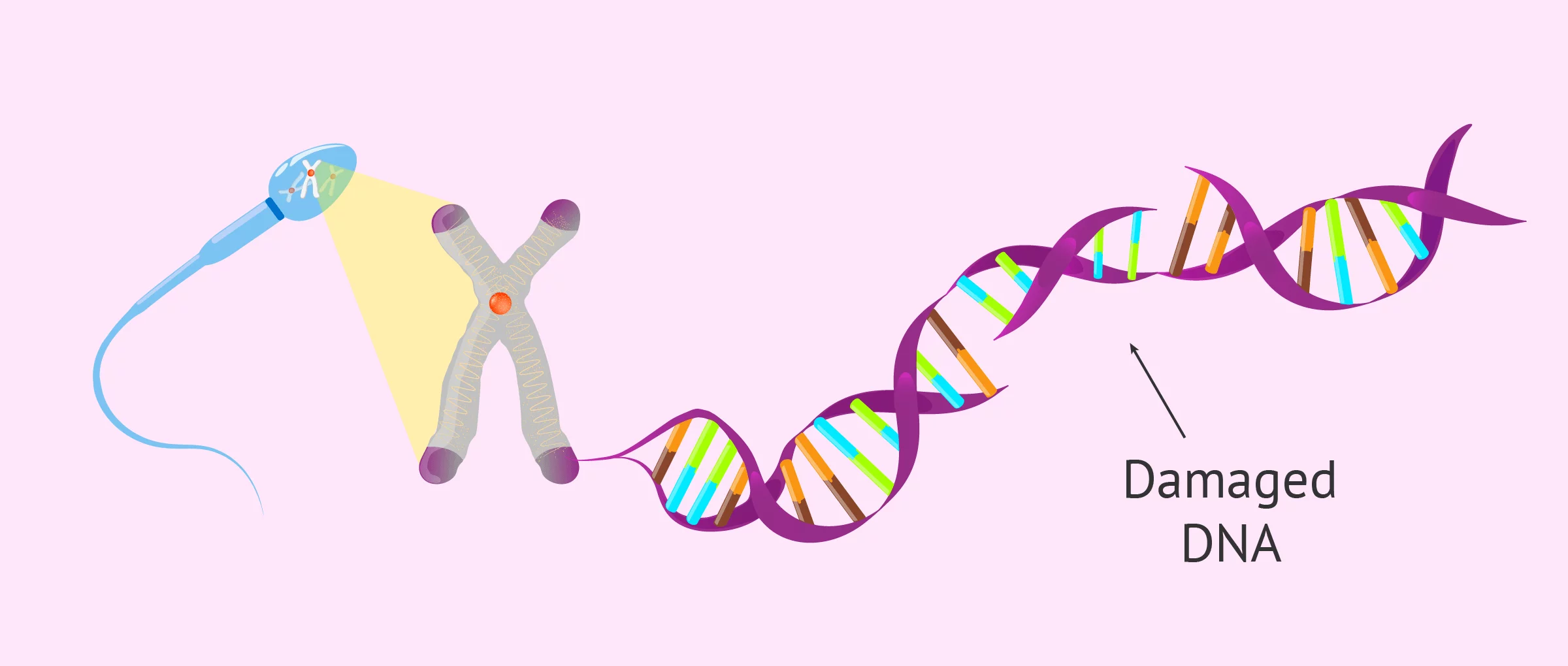
15 Feb Investigating Sperm Integrity And How To Reduce DNA Fragmentation
Investigating the integrity of sperm, behind the standard Semen analysis
Male fertility and sperm quality are evaluated by means of a sperm test or semen analysis report. However, there exist other sperm parameters that are not usually evaluated and can have an impact on fertility as well.
A good example would be sperm DNA fragmentation. It is estimated that about 10-15% of males have alterations in the genetic material of the sperm they produce, whilst common parameters like count, motility, and morphology are normal.
DNA fragmentation refers to the presence of sperm with damaged (broken) DNA, which affects male fertility.
Alterations of any kind in sperm DNA are likely to cause infertility in the man affected, as the integrity of sperm DNA is key to obtaining viable embryos and subsequently a healthy baby.
Sperm DNA Fragmentation – Causes & Effect on Fertility
The higher the sperm DNA damage index, the lesser the chances of achieving an ongoing pregnancy.
For fertilization to result in viable embryos with implantation potential, it is necessary that the DNA of both egg and sperm are free from damage and other lesions.
High DNA fragmentation rates can translate into:
- Reduced fertilization rates
- Poor embryo quality
- Reduced implantation rates
- Increased miscarriage rates
- Poor-quality embryos
- Varicocele
- Recurrent pregnancy loss
- Men who are 45 or older
- Chronic diseases like diabetes
TUNEL assay
The TUNEL Assay (Terminal deoxynucleotidyl transferase dUTP nick end labelling) is a technique used for detecting sperm DNA fragmentation by using benchtop flow cytometer.
The TUNEL method involves staining the sperms using fluorescence microscopy that detects DNA-fragmented spermatozoa only.
When the sample is observed under the flow cytometer or fluorescence microscopy, DNA-fragmented spermatozoa can be seen with greater fluorescent intensity.
SCD test
Sperm Chromatin Dispersion (SCD) test is used to measure the degree of sperm chromatin decondensation.
To this end, sperms are treated using acid and other substances that prevent DNA loops from forming.
As a result, sperms with intact DNA will have larger sperm chromatin dispersion rates, while those with damaged DNA will have low or non-existent halos of dispersed DNA around the head.
Sperm Chromatin Dispersion (SCD) Test
Causes of DNA fragmentation
Over the past few years, evidence has shown that about 25% of infertile men have high levels of sperm DNA fragmentation after doing a sperm DNA fragmentation test.
Many factors can cause sperm DNA to be damaged, including:
- High scrotal temperature. – Due to episodes of high fever, presence of a varicocele, or wearing too tight clothes.
- Seminal infections (such as Chlamydia trachomatis, a bacterium that affects sperm quality.)
- Alcohol – consumption of two or more drinks per day has a damaging effect on sperm integrity.
- Pesticides and high levels of air pollution armaceutical medications
- Tobacco consumption, Men who smoke have a decreased sperm quality. Smoking can increase the concentration of sperm with damaged DNA.
- Advanced age (particularly after age 45 )
- Sperm DNA fragmentation can occur during the sperm production process (spermatogenesis), including failure to identify sperm with defects to eliminate them from the testis, as well as an incomplete sperm maturation process in the epididymis.
- Caffeine: Studies have shown that consuming three or more cups of coffee per day (approximately 300mg caffeine) can damage sperm DNA. This is because caffeine is an effective inhibitor of the cell to repair DNA.
- Recreational Drugs and Medications: Several illicit drugs have been linked with infertility, including marijuana, cocaine, methamphetamines, opioid narcotics, and anabolic steroids. Short term use can lead to a reduction in sperm quality and libido. Chronic use increases the chance that permanent damage will result. In the case of cocaine, residual effects can be seen for up to two years from last use. Medications such as chemotherapy drugs, those used to treat high blood pressure, an overproduction of stomach acid, gout, urinary tract infections, inflammation, certain types of antibiotics, seizures, fluid retention and methadone all lead to a decrease in sperm quality.
- Pollution, Toxins and Radiation: Environmental exposure to pollutants such as dioxin, as well as pesticides and herbicides have been shown to cause sperm DNA damage. Occupational exposures to metals, paints, solvents, degreasers, non-water-based glues can also have a detrimental effect on DNA quality.
Treatment
Not all causes of sperm DNA fragmentation are treatable or can be cured. In all other cases, treatment based on antioxidants is typically enough to improve sperm quality.
Oxidative stress caused by an increased number of free radicals in the man’s organism causes damage to sperm DNA. For this reason, leading a healthy lifestyle and a balanced is key to reduce the levels of sperm DNA fragmentation.
Antioxidants for 2 or 3 months can help reduce the levels of sperm DNA fragmentation by 20%.
On the other hand, seminal infections should be treated with antibiotics to reduce the levels of sperm DNA fragmentation. Surgery to treat varicocele also improves sperm DNA integrity and subsequently boost male fertility.
Effect on pregnancy
The fact that a man has elevated levels of sperm DNA fragmentation does not mean that conceiving naturally is impossible. However, the chances of success decrease due to all the reasons explained above.
If the fragmentation index is rather low, it is possible that the egg fixes the damage by itself after fertilization. Although this mechanism of action is still to be studied, it depends highly on the type of damage and egg quality.
In spite of all this, patients with a percent of sperm DNA fragmentation above 30% should go directly for IVF with ICSI treatment, also known as IVF-ICSI.
Call 9339 1999 or book a FREE scoping session online to speak with Jacky about preconception, fertility and pregnancy. Resources:
https://www.ncbi.nlm.nih.gov/pmc/articles/PMC5643651/
https://www.mdpi.com/2076-3921/9/3/219/htm
https://journals.plos.org/plosone/article/file?type=printable&id=10.1371/journal.pone.0216143
https://www.tandfonline.com/doi/full/10.1080/2090598X.2019.1599624

